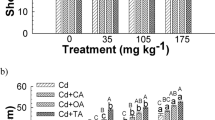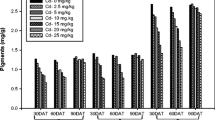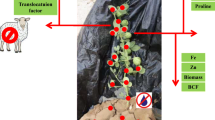Abstract
Plants can be used to remove heavy metal from the environment and hence reduce the toxic effect of heavy metal on health of all living organism. Cadmium is a non-essential heavy metal that does not have any metabolic use and can be harmful even at low concentrations. Fenugreek (Trigonella foenum-graecum L.) and Blackgram (Vigna mungo L.) are two important pulse crops grown in India to eradicate the malnutrition and hunger from developing country like India. Plants were grown in pots treated with 60 mg Cd kg-1 soil as CdCl2 caused significant damage to both the crops. The toxicity was significantly reduced when these plants earlier treated with Cd with different plants parts of neem. The changes in plant height, fresh as well as dry weights, percent pollen fertility, number of pods per plant, total chlorophyll content and nitrate reductase activity were observed. The highest improvement was noted in those plants treated with neem fruits alone while the minimum in those plants treated with Cd, neem leaf respectively. The effect was more pronounced in fenugreek than blackgram.
Access provided by Autonomous University of Puebla. Download chapter PDF
Similar content being viewed by others
Keywords
- Chlorophyll Content
- Sewage Sludge
- Nitrate Reductase Activity
- Total Chlorophyll Content
- Sewage Sludge Application
These keywords were added by machine and not by the authors. This process is experimental and the keywords may be updated as the learning algorithm improves.
Introduction
Fenugreek (Trigonella foenum graecum L.) and Blackgram (Vigna mungo L.) are important pulse crops. These have immense value and a good source of vitamins, proteins and essential oils. These crops are very important for agricultural economy and ability to increase soil fertility. Plant pathogens cause serve losses in productivity of fenugreek and blackgram [1, 2]. Cadmium (Cd) is a common metal pollutant introduced into the environment through industrial activities, sewage sludge application and commercial phosphorus fertilizers and subsequently become a part of the food chain [3]. Therefore, it is very essential to manage pathogens and reduced phytotoxicity of Cd in order to produce more plant biomass and grain of improved quality. This management objective can be achieved with the help of chemical fertilizers, broad spectrum pesticides and organic amendment of plant origin [4]. Bioorganic organic farming is a new concept that recently introduced in agriculture with an eye to stop applying the enormous amounts of agro chemicals that led to serve environmental and health troubles. The conjoint application of botanicals as organic manures is a suggested alternative way to replace the chemical fertilizations and obtain reasonable yield quality and high quality. This not only to reduce the phytotoxicity of Cd but increased the soil fertility. The present investigation aims at studying the different parts of neem plant and Cd individually as well as concomitantly in relation to growth parameters of fenugreek and blackgram.
Materials and Methods
The pot experiments were performed in randomized block during Rabi and Kharif season of (2010) in the net house of Department of Botany, Aligarh Muslim University, to investigate the efficacy of some botanicals such as Fenugreek (Trigonella foenum graecum L.) and Blackgram (Vigna mungo L.) respectively. The aim of these experiments were to study the toxicity of Cd alone and in combination with neem plant parts such as neem leaves and neem fruits.
The seeds of Trigonella foenum- graecum L., and Vigna mungo L., were obtained from Indian Agricultural Research Institute, New Delhi. The seeds were surface sterilized with dilute solution of sodium hypochloride to prevent any fungal contamination. The 10 seeds of Trigonella foenum-graecum L. and Vigna mungo L., were sown is earthen pots containing 4kg steam sterilized soil – manure mixture. Thinning was done after one week of seed germination and retains five plants per pot. The concentrations of Cd in the form of (60mg Kg-1 of soil) CdCl2, Cd + neem leaves, Cd+ neem fruits @ 110kg N/ha alone and in combination were added before sowing of seeds as per inoculation scheme in Table 1 and 2. The plants with no added heavy metals served as control. The treatments were given at a temperature of 22±2°C before 1 day of sowing. There were five replicates of each treatment. Necessary watering and weeding were done whenever required. The plants were kept at glasshouse benches in the randomized manner.
The experiments were terminated 120 days after seed germinations. Plant height, fresh as well as dry weights, percent pollen fertility, number of pods per plant, total chlorophyll content and nitrate reductase activity were measured. Pollen fertility (%) was estimated by the method of Brown [5], using stainability of pollen grains in 1% acetocarmine solution.
Chlorophyll Estimation
The chlorophyll content in the fresh leaf was measured by Mackinney [6], 1g of finely cut fresh leaves was ground to fine pulp using mortar and pestle after pouring 20 cm3 of 80% acetone. The mixture was centrifuged at 5,000 rpm for 5 minutes. The supernatant was collected in 100 cm3 volumetric flask. The residue was washed three times, using 80% acetone. Each washing was collected in the same volumetric flask and volume was made up to the mark, using 80% acetone. The absorbance was read at 645 and 663nm on spectrophotometer. The chlorophyll content present in the extract (mg kg–1 tissue) was calculated by following equation:
Chlorophyll a kg-1 tissue = 12.7 (A663) – 4.68 (A663) ×
Chlorophyll b kg–1 tissue =20.2 (A645) – 18.02 (A663) ×
Total chlorophyll in fresh tissue = 20.2 (A645) + 8.02 (A663) ×
A =absorbance at specific wavelength
V =final volume of chlorophyll extract in 80% acetone
W=fresh mass of tissue, used for extraction
NR Activity Estimation
The activity of nitrate reductase was measured by Jaworski [7]. The leaves were cut into small pieces (1cm2). 0.2g of these chopped leaves weighed and transferred to plastic vials. To each vial 2.5cm3 of phosphate buffer pH 7.5 and 0.5cm of potassium nitrate solution was added followed by the addition of 2.5 cm3 of 5% isopropanol. These vials were incubated in BOD incubator ± 2°C in dark 0.4 cm3 of incubated mixture was taken in a test tube to which 0.3cm3 each of sulfanilamide solution and NED_HCl was added. The test tube was left for 20 minutes, for maximum colour development. The mixture was diluted to 5cm3 with DDW. The absorbance was read at 450nm on spectrophotometer. A blank was run simultaneously with each sample. Standard curve was plotted by using known graded concentration of NaNO2 (Sodium nitrite) solution. The absorbance of each sample was compared with that on the calibration curve and nitrate reductase activity (n mg-1 h-1) was noted on fresh mass basis.
Results and Discussion
The data presented in Table 1 and 2 clearly revealed that soil application of some botanicals and Cd alone as well as in combination with neem leaves and neem fruits significantly improved the plant growth, percent pollen fertility, and chlorophyll content in all treatments as compared to the untreated control. The highest improvement was noted with neem fruits and lowest was recorded with Cd + neem leaves and Cd alone respectively. The application of neem plant parts to soil is beneficial effects on soil nutrient, soil physical condition, soil biological activities and improvement of crop.
The improvement was more prominent in growth parameters of Trigonella foenum –graecum than Vigna mungo. The improvement may be due to reduction in plant pathogens and due to their manurial effect. Incorporation of botanicals increased microbial activity are known to bring about increased conversion of N to nitrate form [8]. Which in turn appears to be responsible for stimulation of nitrate reductase activity. Similarly chlorophyll content was also increased by amendments with their botanicals. Ahmad et al., [9] also observed increased chlorophyll content due to application of organic matter. The application of Cd caused much reduction in all the growth parameters including NR activity and chlorophyll content of both the crop plants. Our results are in conformity with those of Mobin and Khan [10], who observed reduction in phytosynthetic content even at low concentration. Arduini et al., [11] and Khan et al., [12] also noticed reduction in plant growth and enzymes activity in the presence of Cd inoculated plants. However, addition of neem plants parts reduced the toxicity of Cd when inoculated concomitantly. This is an agreement with those of Braek et al., [13] and Wang and Wood [14] when incorporated with algae and Azolla with heavy metals respectively.
The researcher outcome suggests the aptness of botanicals for management of diseases caused by fungi, insects and plant- parasitic nematodes along with affluence of soil health if the crop is managed under the umbrella of organic farming. The economics of using botanicals also works out to be adequate in high value commodity in pulse crops. Thus, the present finding strongly advocate the array of botanicals in general and neem in particular for pest management as well as reduction in phytotoxicity in an organic agriculture. Organic pulses are considered valuable and it is also believed that post- harvest losses of such vegetables are usually lower as to conventionally grown pulses. Such types of produce are free from any health hazard and also safe for environment.
References
S.A. Tiyagi, M. Parveen, A.A. Khan, and R. Kumar; Ann Appl Biol 118 (1991a), 106–107.
S.A. Tiyagi, M. Parveen, A.A. Khan and R. Kumar; Ann Appl Biol 118 (1991 b), 106–107.
G.J. Warner, Adv. Agron 51(1993), 173–212.
S.A.Tiyagi, M.M. Alam; Bioresour Technol 51 (1995), 233–239.
Brown, G.T., 1949. Pollen slide studies, Springfied, Illinios, USA: Charles C. Thomas publication.
G. Mackinney; J. Biol. Chem., 40 (1941), 315–322.
E.G. Jaworski; Biochem. And Biophys. Res. Comm., 43(1971), 1274–1279.
H.B. Gunner; Nature 197(1963) 1127–1128.
A. Ahmad S.A. Tiyagi M.M. Alam; Science Khyber, 3(1990), 165–170.
M. Mobin, and N.A. Khan; J. Plant Physiol., 164(2007.), 601–610.
I. Arduini, A. Masoni, M. Mariotti and L. Ercoli; Environ. Exp. Bot., 52 (2004), 89–100.
N.A. Khan, I. Ahmad, S. Singh and R. Nazar; World J. Agric. Sci., 2(2006), 223–226.
G.S. Braek, D. Malnes and A. Jansen; J. exp. Mar. Biol, Ecol,42 (1980): 39–54
H.K. Wang and J.M. Wood, Environ. Sci. Tech., 18 (2) (1984)). 106–109
Author information
Authors and Affiliations
Editor information
Rights and permissions
Copyright information
© 2012 Springer-Verlag Berlin Heidelberg
About this chapter
Cite this chapter
Perveen, R., Faizan, S., Tiyagi, S., Kausar, S. (2012). Phytoremediation Potential of Induced Cd Toxicity in Trigonella Foenum-Graecum L. and Vigna Mungo L. by Neem Plants parts. In: Khemani, L., Srivastava, M., Srivastava, S. (eds) Chemistry of Phytopotentials: Health, Energy and Environmental Perspectives. Springer, Berlin, Heidelberg. https://doi.org/10.1007/978-3-642-23394-4_71
Download citation
DOI: https://doi.org/10.1007/978-3-642-23394-4_71
Publisher Name: Springer, Berlin, Heidelberg
Print ISBN: 978-3-642-23393-7
Online ISBN: 978-3-642-23394-4
eBook Packages: Earth and Environmental ScienceEarth and Environmental Science (R0)




